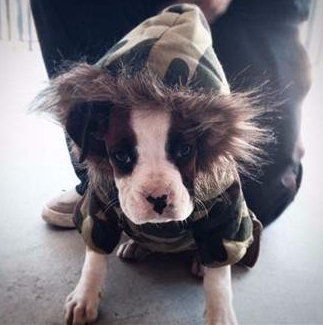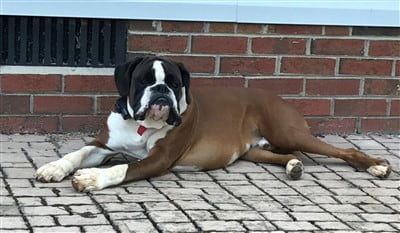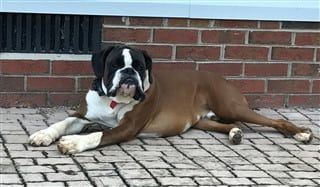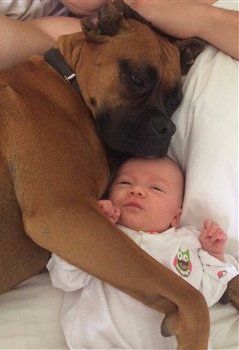Boxer Dog Winter Care
Overview
If you live in an area that has noticeable change during the wintertime such as dry air and cold weather, you’ll want to take a few steps to prevent winter related issues common with the breed.
While a chilly, wintery day here or there won’t have much of an effect on a Boxer dog, weeks and months of oppressively cold, dry air and icy, snowy outside elements will. It can affect the nose, paws, skin and coat. You may also notice some behavior changes such as change in appetite and a restlessness.
Since many of these issues are compounding, most winter care tips for Boxers work best if you preemptively take steps to prevent these things instead of waiting until the problem has had time to develop into something serious.
For these reasons, this section will cover everything you need to know about taking care of a Boxer puppy or dog in the winter. We’ll go over:
- General Winter Concerns
- Exercise, Activity and Restlessness
- Appetite Changes
- Shedding
- Paw Care
- Nose Care
- Skin and Coat Care
- Cold Intolerance
Please note: AllBoxerInfo is reader-supported. Some of the product suggestions on this page are affiliate links. As an Amazon Associate we earn from qualifying purchases. This is at no extra cost to you and helps keep this site running.
Loca, photo courtesy of Jim Wallace
Winter Related Concerns with the Boxer Dog
There's both indoor and outdoor elements to address that will affect your Boxer in the winter, as well as specific care to keep the most common wintertime issues at bay. And, if you're off to a late start on some of this, we'll also cover treatments, as well, to get your Boxer back into good shape.
Humidity Levels in the House
What happens:
You might notice that your skin gets a bit dry in the winter, but for dogs, it can do that and much more. Constant arid air can cause skin to get itchy (if your Boxer is licking at his paws and nibbling at himself, this is one of the possible reasons), but it can also cause peeling and flaking.
Another concern is that super dry air can cause breathing issues with the Boxer dog. The throat will get scratchy and the dog may start to snore at night. With brachycephalic breeds like the Boxer, this winter related issue is more prevalent than with other breeds.
What to do:
The most effective way to combat this is to use quality humidifiers in the house. If you can’t keep them going in all rooms, at least have one in the main room where your Boxer puppy or dog spends most of his time or place one beside his sleeping area (particularly if you notice issues at night such as a dry cough or snoring).
There’s some at-home remedies, such as keeping the bathroom door open when showering, getting house plants and placing out bowls of water (more effective if placed on radiators), but these do not work as well as humidifiers.
Exercise, Activity, and Restlessness, Plus Cold Intolerance
When winter = less outdoor activity - It’s not uncommon and it’s completely understandable that many owners don’t take their Boxer dogs outside as much in the winter. However, this can have negative consequences. Over the course of a day, dogs (puppies especially, but Boxers of all ages) build up a reservoir of energy.
This is released when they are taken out for purposeful exercise. If this activity time is reduced or plain-out skipped, where is that energy going to go? A restlessness can develop that is the canine equivalent of cabin fever. It can make a dog stressed, and there may be some chewing on non-toy items or other signs of destructive behavior.
Wintertime restlessness can also develop due to a dog going for long periods without the opportunity to engage his canine senses. Dogs are better behaved and are able to relax when they have periods during the day to fully use their incredible canine scent detection and hearing.
In regard to cold intolerance, some people assume that just because a Boxer is big and strong looking, that he can withstand the outdoor elements. Not necessarily so. Some Boxers do not like being outside, or being cold. The ability to be out in the cold with or without precipitation, all depends on a Boxer's age (young pups and seniors have more trouble), how long he is outside, the actual temperature and wind chill, his personal acceptance of weather conditions, body fat percentage, and his health status.
In regard to how long a Boxer dog can stay outside in freezing winter weather, keep in mind that wind chill should be looked at as opposed to just air temp. With that in mind, with a temp above the freezing mark of 32F, a Boxer can handle being taken out for a good 20 to 30 minutes, 2 or 3 times per day.
If your yard is enclosed and safe, he can run around in the snow as well, but don’t leave him there unsupervised; you won’t be able to see how he’s handling the snow and getting covered in wet snow will make him get colder, faster.
What to do:
It's very important to make sure that your Boxer feels really comfortable when outside in the winter. If not, this can impact both house training and exercise. And limiting exercise affects everything from mood to weight (loss of muscle mass, increase in fat). You don't want your Boxer lean and in good shape for just half the year.
If it’s under 32F, winter-proofing his paws and nose (more ahead) and placing quality clothing on your Boxer
such as a vest to help keep his core temperature warm and protected, will allow him to tolerate cold air and winter weather exposure. If you start getting super cold temps in the range of negative 20, just 10 minutes is about the duration you'll want your dog to be out. Tails and ears are prone to frostbite.
A huge hurdle in this regard is that owners get cold faster than their dog and it’s the owner who rushes back inside before the Boxer is allowed to release his pent-up energy, engage his muscles and get his needed exercise. Dress up super warm yourself and you’ll be more prone to bring your Boxer out.
***
Young puppies under the age of 6 months often have very little cold tolerance and short 10 minutes trips for bathroom needs may be all that they can safely handle.
***
If there is severe weather such as blizzard conditions or freezing sleet it’s best to keep your Boxer inside.
So, if needed, obtain a quality, weather-resistant winter coat for your Boxer. Most appreciate the extra layer that it gives. Then, dress up warm yourself and enjoy the outdoors!
Appetite Changes in the Winter
You may wonder if Boxer dogs eat more or less in the winter. And the answer to this depends quite a bit on the extent that you keep up his activity level. All things being equal, if he is exercising as much as normal, he will tend to eat more. There can be as much as a 20% difference between winter and summer daily food consumption.
If your Boxer is less active in the winter, you may notice a decreased appetite and this is mainly due to the dog self-regulating.
If your adult Boxer is eating more but moving less and is gaining winter weight, you may want to offer the same amount of food but have it consist of fewer calories. This can be accomplished by removing some of the higher calorie food and replacing it with low calorie ingredients such as peas, carrots, string beans, blueberries, and raspberries.
Biscuit snacks can be replaced with frozen fruit (banana, mango, watermelon, blueberries, raspberries) and/ or with raw baby carrots.
Peyton, photo courtesy of Adam Benim
Boxer Dog Winter Shedding
Boxers tend to shed as winter is approaching and then as it is ending. This is triggered, for the most part, by the change in daylight hours and not so much due to the actual changing weather. Therefore, even if you live somewhere where you get little to no snow, you’ll still most likely see this change.
During both of these transitions and throughout the winter when the coat is thick, it’s important to keep up with grooming. You’ll want to use a good de-shedding tool to pull out dead hair and a good brush to sweep through the coat to keep it healthy.
Since a moderate amount of dead hairs can fall back into the Boxer’s coat, it’s important to brush deeply (pulling hair that is trapped near the skin), thoroughly (the entire body) and on a regular basis (at least once a week).
A ZoomGroom Brush
 is a great tool to use for this.
is a great tool to use for this.
Since you’ll be dealing with winter air, using a leave-in coat spray (more ahead) while you brush your Boxer will help the coat retain proper moisture, for shiny healthy fur all winter.
Boxer Dog Paw Care in the Winter
Like many other parts of a dog’s body that undergo change in the winter due to cold, dry air and outside wintry conditions, the paws are one that really takes the brunt of what the season doles out.
Let’s go over a quick review of what a Boxer’s paws are like:
- Just like other areas on a canine’s body, there are just 3 layers of skin (compared to our 5). The skin on the pads is thicker (more cells) than other areas.
- However, depending on what type of surfaces your Boxer routinely walks on, the paws may be softer or more durable.
- To help paws become tough without causing injury, it takes lots of time walking over different surfaces. The pads are also cushioned with fat (which does protect them to a certain degree from the cold) and connective tissue (which acts as a shock absorber).
What can happen in the winter:
Any surface that a dog walks over is going to have an affect on the paws. It can be a good thing, such as a
gradually toughening them,
but in the winter it can cause immediate or cumulative damage:
- Sharp ice shards can cause small cuts. These may range from very small (but will build up over time to something more serious) or moderate in which the Boxer puppy or dog may favor the paw and/or lick at it.
- Small pieces of snow can become wedged between the toes or pads. It melts, refreezing into ice, and stretches the skin there. This is known as ‘snowballing’ and can be quite painful.
- One of the biggest winter concerns is chemical burn from ice melt products and damage due to salt. Even if you don’t use these treatments yourself, most city municipal services do and this is tracked in by vehicles traveling from treated roads into your neighborhood.
- Additionally, dogs can use some help with traction in the winter when powering over ice and snow.
How to protect the paws:
The best thing you can do for your Boxer in the winter is to prevent paw issues before they start by using a quality paw wax.
Paw wax at any time of the year will help keep them healthy. However, a good one will add a breathable layer of protection that prevents snowballing and offers a barrier from winter chemicals and even the cold. Another great element is that wax helps a dog with traction (this product is a vital element of caring for sled dogs) and finally, if your Boxer does have some skin issues
there (dryness, peeling, irritation), a good canine paw wax will aid in allowing those things to heal.
You'll want to look for a paw wax that is non-oily, absorbs fast, and is durable. Our go-to, top recommended product is Musher's Secret Paw Protection Wax . It's super effective and helps heal issues as well, such as dryness, peeling, and/or cracking. This is applied every 10 to 14 days.
. It's super effective and helps heal issues as well, such as dryness, peeling, and/or cracking. This is applied every 10 to 14 days.
Boxer Dog Nose Care in the Winter
A dog’s nose is super vulnerable to both the inside and outside environment. With nothing to protect it, if dry cold air affects any one body part, it’s often the nose that’s the first to show the effects.
A review of a dog’s nose skin:
- With 3 layers of skin, the outer most layer, called the stratum cornuem, consists of the grooves that give it a textured appearance. It is prone to drying, peeling and cracking. If any part of that top layer peels off, you’ll see pink skin underneath.
- Nose issues can be very painful for a dog and once an issue starts, it will often get worse very quickly without intervention. For this reason, taking care of your Boxer’s nose in the winter is an important part of winter care.
What can happen in the winter:
There are 2 main culprits here:
Dry air – It’s hard to escape this during the winter. When the weather is cold, humidity is low; therefore, the air holds much less moisture in the winter than it does during any other time of the year.
And staying inside can’t help with this. When cold arid air is heated, it simply warms up. No moisture is added. And of course, the air in your house is recirculated air from outside, every time you open the door, new dry air comes in.
Licking
– In general, a dog’s nose will vary from dry to wet all throughout the day. However, for most healthy dogs, the nose does hold some moisture.
In addition, a dog typically licks his nose 200 times per day. Many of these licks are not noticed by owners; it’s a flick that is so quick, it’s unseen unless you were to stare at your Boxer to attempt to count!
Outside, licks combined with cold winter winds can cause a Boxer dog’s nose to become chapped. You may not notice on day one. However, on day two, he’s out again, licking a slightly chapped nose and now it’s moderately chapped. Day three and day four, now issues may begin.
Inside, the air is dry (if you’re not taking steps to combat this) and with normal licking in an arid environment and the chapping worsens as well. A chapped winter nose can lead to itching, peeling, cracking, and possibility of infection.
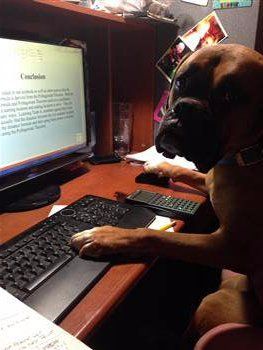
Dixie, at 5 years old, photo courtesy of Andy Kiddle
How to protect the nose:
As with most wintery elements, prevention is key. Though, if there is already some peeling and cracking, if you use the right product, you can treat these issue from home. Cracking
in which puss oozes out or bleeding from deep cracks often needs to be treated by the vet, as infection may be present.
To prevent winter related issues with the nose, you will want to routinely use a quality nose balm. It will keep it properly hydrated during the winter (though we recommend maintenance levels all year round, with summer being a concern as well). And, it offers a layer of protection to shield the nose from wind burn, chapping and the drying effects of arid air both indoors and outside.
It’s important to choose a product that is all natural. Some contain chemicals and additives that not only are not effective, but can also cause more irritation to an already sensitive area.
One of the best nose balms is Natural Dog Company's Snout Soother . It’s remarkably effective at prevention and great at healing everything from dryness to cracking. For normal winter maintenance, apply this 1 time per week. For healing such things as peeling and cracking, you’ll want to apply this 2 to 3 times per day and then fall into the once daily application once it has healed.
. It’s remarkably effective at prevention and great at healing everything from dryness to cracking. For normal winter maintenance, apply this 1 time per week. For healing such things as peeling and cracking, you’ll want to apply this 2 to 3 times per day and then fall into the once daily application once it has healed.
Boxer Dog Skin and Coat Care in the Winter
Does your Boxer’s coat look dull and dry in the winter? If so, you’re not the only owner to notice this.
The cold dry winter air can have a brutal effect on both skin and coat. Skin will become dry (you may notice some flaking) and the coat can lose its shine. Over the course of the season, it can become coarse and brittle, essentially looking like the epitome of unhealthy fur.
What can happen in the winter:
It’s that darn dry, cold air that’s at work again. And remember, even inside, your heating system will add heat but not moisture. Luckily, there’s several things you can easily do to keep your Boxer’s skin and fur super healthy all throughout the season.
Baths
– Many owners tend to give less baths in the winter. After all, with the ground frozen and often with less outings outside, a dog doesn’t seem to get as dirty. However, it’s important to remember that baths are not just for removing debris. A canine’s body slowly releases body oils that act as a natural lubricant and moisturizer. These build up over time.
At just about the 3-week mark, there is enough that it is accumulating deep under the fur at the skin’s surface. It’s beginning to block skin pores. And it’s starting to smell. Giving your Boxer his wintertime baths will remove all that, give him a ‘clean slate’ and if you use the right products, help to properly moisturize the skin and fur. So, continue to give your Boxer puppy
or dog a bath every 3 weeks for proper winter care.
Keta, at 3 years old, photo courtesy of Kerry de Viet
Bath products
– Soap is soap, right? As long as it makes lather, we’re good to go?
No, not at all.
Some products (cheap ones) are not properly pH balanced. pH is the level of alkaline and acids in the product. If it’s not right for canines, it can cause dry coarse fur and irritate skin.
This is why you shouldn’t use human shampoo or cheap shampoo on a dog. Humans need a pH balance of about 5. Dogs need a pH balance of 7 to 7.5. We need different levels than our dogs because our epidermis (the top layer of skin) is 18 to 20 cells thick and it is only 8 to 10 cells thick on canines.
In addition, part of winter care for a Boxer should involve making sure the bathing products add even extra moisture to combat what the dry air is continually sucking out moisture. If the skin is already irritated and itchy, consider use a specialty shampoo to restore things (see below).
Protecting the fur:
If you’ve used the right products, that great. But now the shampoo is washed out and the conditioner will only protect to a certain degree.
For this reason, it can be really helpful to protect the fur with a leave-in product.
It will serve several purposes:
- Reduce static
- Reduce damage from contact friction (the continual wear on the coat from contact and movement again surfaces)
- Prevent breakage
- Help both skin and coat retain moisture
- As an added bonus, it gives a nice, clean scent
Be sure to get all areas of the body, even the tail. If you keep on a regular schedule, this only needs to be done about 2 times a week. If you have any left at the end of winter, no worries, this is great in the summer
too, to prevent the drying effects of the sun and the fading that can go along with that.
Recommended wintertime coat products:
For shampoo and conditioner, Earthbath Oatmeal & Aloe Shampoo
 is awesome, as is their conditioner. This is ideal for regular use to keep skin and coat healthy.
is awesome, as is their conditioner. This is ideal for regular use to keep skin and coat healthy.
For a leave-in coat spray, Earthbath All Natural Deodorizing Spritz
 is super-effective. There's several different fragrances like including Eucalyptus and Peppermint, Green Tea Leaf, Lavendar, and Mango. This keeps skin and coat in great shape, and keeps a Boxer smelling pretty good in between baths.
is super-effective. There's several different fragrances like including Eucalyptus and Peppermint, Green Tea Leaf, Lavendar, and Mango. This keeps skin and coat in great shape, and keeps a Boxer smelling pretty good in between baths.
If your Boxer's having skin and coat issues, like super dry skin and/or itching, opt for a specialty shampoo. Moosh Shampoo
 cures a wide range of issues, and is 100% all-natural and organic.
cures a wide range of issues, and is 100% all-natural and organic.
Summary
We covered a lot, so here's the round-up:
- Maintain good humidity levels in the house
- Get your Boxer a warm vest or coat if there cold intolerance, so you can keep up with exercise requirements
- Expect some shedding as winter approaches, keep brushing the coat on a regular basis
- Protect the paws with a good paw wax and protect the nose with a good balm
- Give baths every 3 weeks, using quality products
- Use a coat spray
- Use a special shampoo if there's dry skin and/or itching
A Final Word
No doubt, for many people winter is miserable and dreams of one day relocating south are strong in their minds. Alternatively, you may be true New Englanders like us or live in another area where cold snaps and winter storms are just part of the package.
In either case, please remember that while Boxers are strong powerful dogs, they are not invulnerable to the effects of winter.
Implementing winter care for Boxers to prevent dry chapped noses, paw issues, skin & coat damage, and issues like restlessness and appetite changes is easier if you plan ahead and have what you need on hand to ‘winterize’ your Boxer. He or she will (silently) thank you for it, and before you know it, spring will come. And then… summer, at which time we will, of course, all say that it’s too hot and muggy.
You may also like:
Boxer Dog Water Requirements
- How much water a Boxer should be drinking each day and ways to help your puppy or dog reach that goal.
Boxer Dog Paw Issues
- Covers what can go wrong and how to fix issues. Includes sores, itching, rashes, irritation and more. Prevention and treatment.
Boxer Dog Feeding Guidelines
- How much to feed your Boxer pup or adult, schedules, dry vs wet, and top recommendations for optimal health for pups, adults and senior Boxers.
Boxer Dog Allergies
- Resolve allergies for good. Steps to reduce allergens and treat symptoms, including home remedies. Covers all 3 types: Contact, food, and environmental.
Boxer Dog has Odd Colored Urine
- Reasons why the urine may be discolored and what this can point to.

